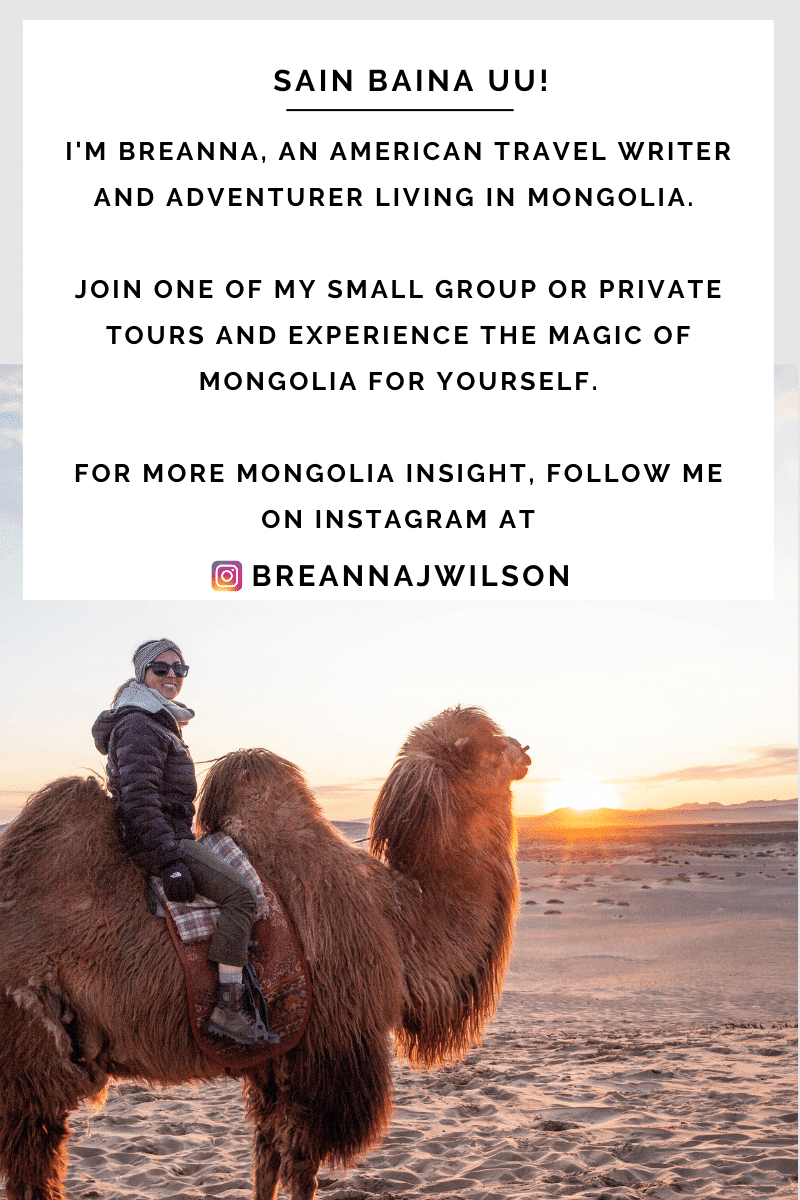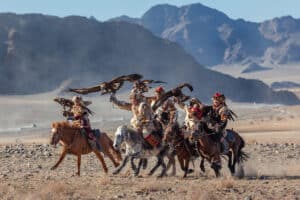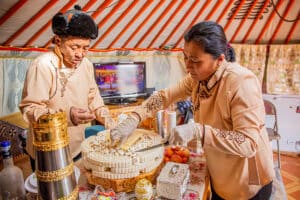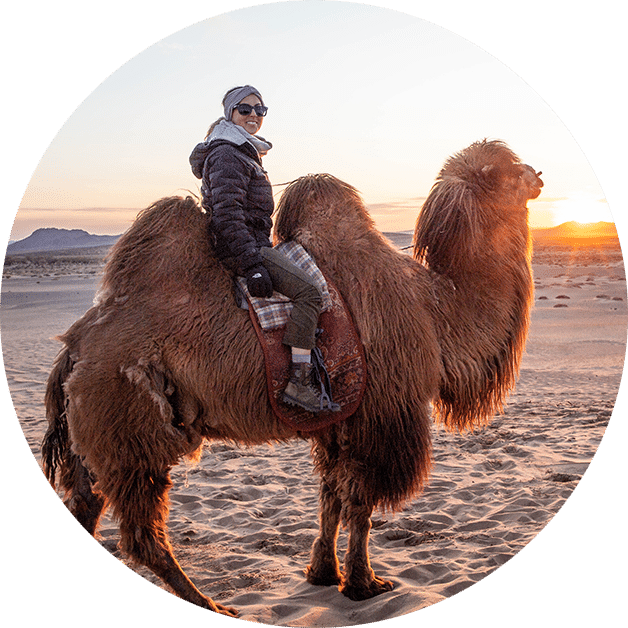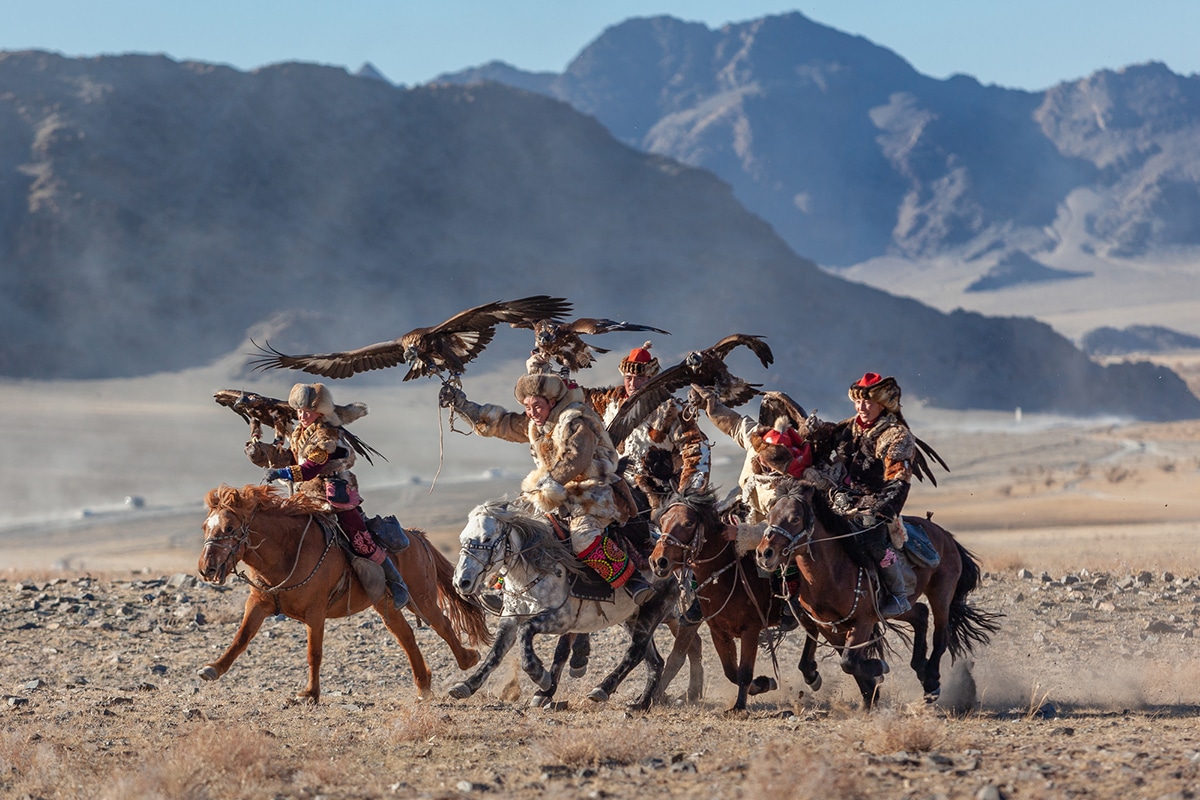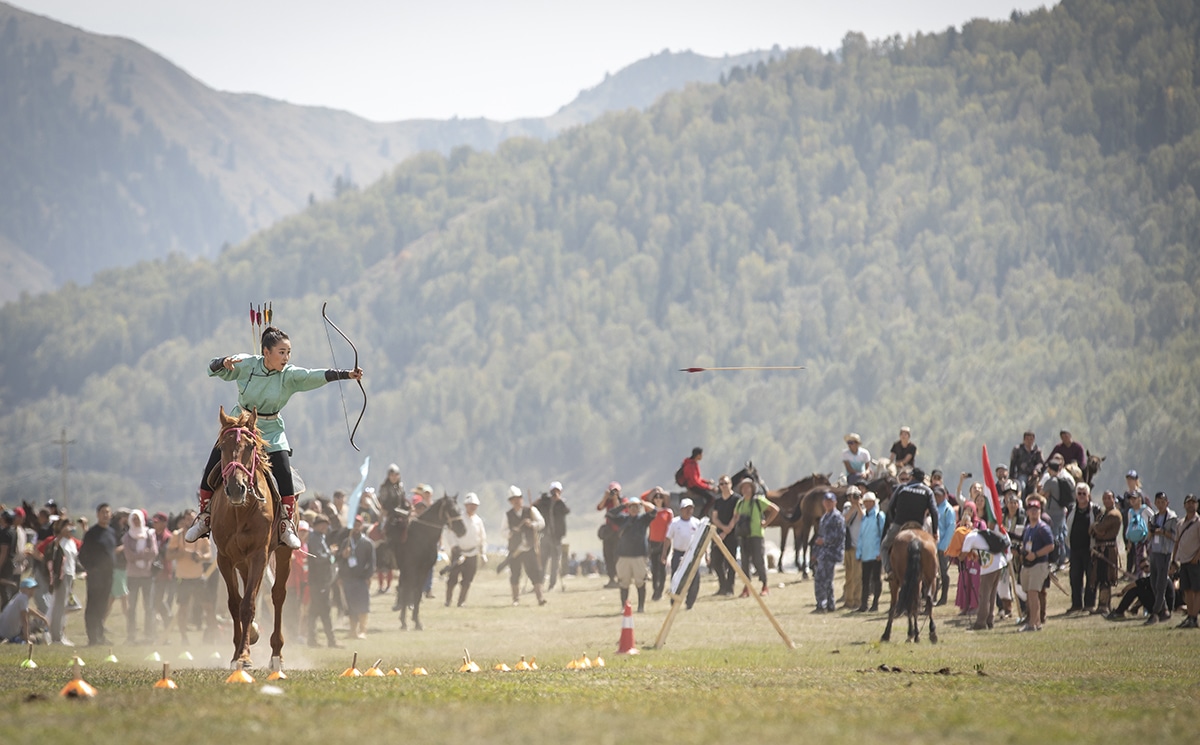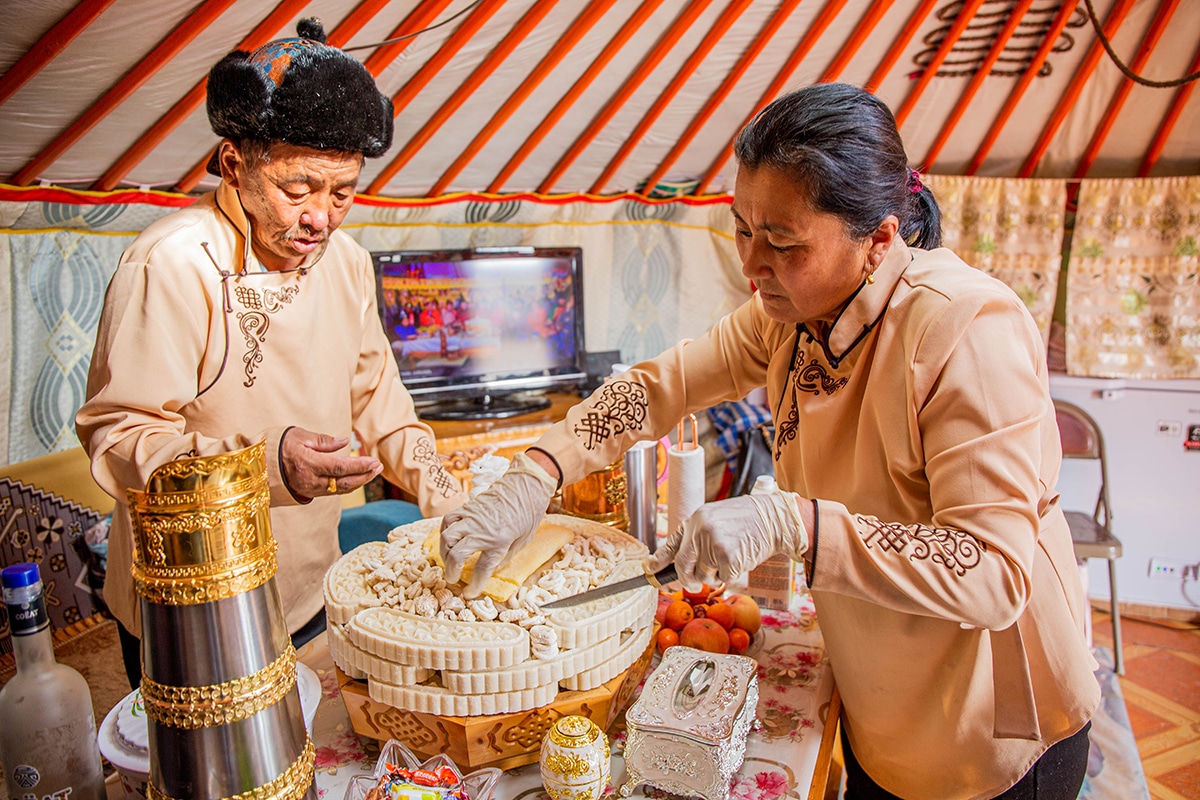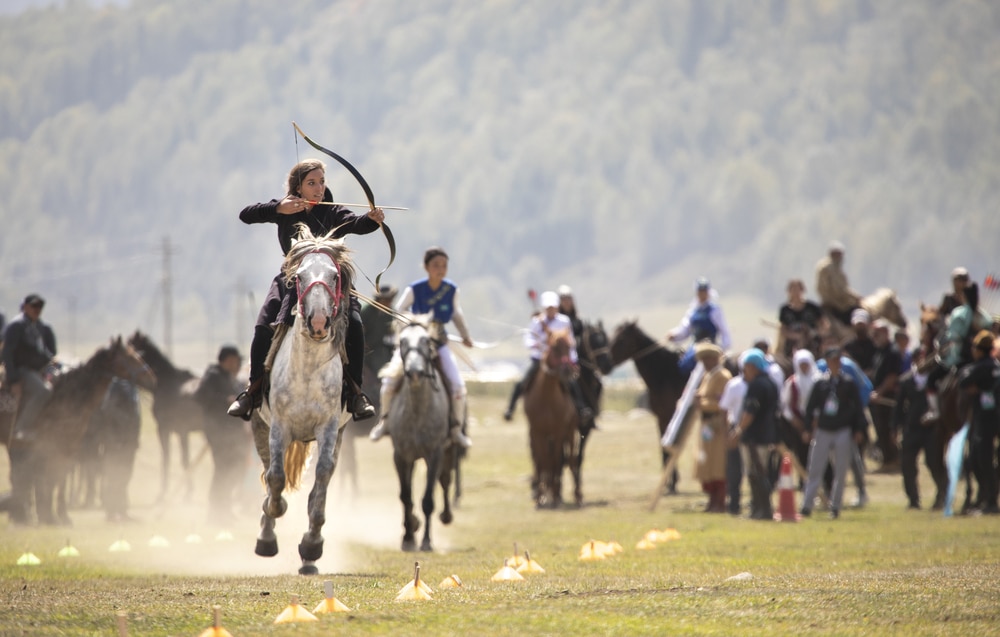The Ultimate Mongolia Travel Guide 2024
From the best time of year to visit to how to get a SIM card and where to register with immigration, these are the important things to know as you plan your trip to Mongolia.
- April 9, 2020
- Updated: January 24, 2024
Table of Contents
When I say I love living in Mongolia, I mean it with every part of my heart and soul. It was after coming here in 2018 as a tourist to join a Mongolia tour and experience the local culture that I remember thinking, this place can’t be real.
It turned out to be the best way to experience Mongolia I could have asked for. That short trip made me realize the Mongolian steppe is one of the last truly untouched places in the world for nature lovers and true adventure seekers.
Nomadic families really did still live of the land, and their herds, the same way they have for thousands of years. Talk about sustainable.
In fact, 25% of the Mongolian population still lives this way. That’s a huge percentage in a country of just over 3.2 million.
However, it wasn’t just the Mongolian countryside that I fell in love with. After coming back and living a summer in Ulaanbaatar (also written as Ulan Bator), Mongolia’s capital city, I knew this was the country, and the place for me.
It’s by no means easy living here. This is not the United States, where everything runs smoothly. Language barriers are a thing, credit cards always have issues (especially Mastercard), and you really need to get used to Mongolian time. Whether you want to or not.
In the end, I’ve learned it’s better not to resist this style of living and just go with the flow. It’s probably the only reason I’ve made it this long here. Living here has taught me a lot about patience, compassion, and myself. Things living in Los Angeles, New York, and growing up in Pittsburgh couldn’t do in 32 years.
Because, when it comes down to it, Mongolia is a tough place to be as a foreigner among the local people. When I moved here, there was no information on how to navigate the the city, let alone rural Mongolia. I’m talking, nothing! I had to become my own local guide.
Not just for people crazy enough to move here like me, but for travelers, too. The type of people willing to travel more than 24 hours to a place where they usually have no idea about the chaos they are about to encounter. The kind of people who book a tour but the tour company could be real and you could have the adventure of the lifetime, or it could be a complete scam. The people who just go for it with fearlessness without ever looking back. Those are my people. You are my people.
So, I hope this Mongolia travel guide, along with the other guides on this Mongolia travel blog give you the insight and information that wasn’t available to me when I first came here. That these articles will help you navigate Ulaanbaatar like a local and Mongolia like a travel pro.
As always, if you need help planning an itinerary or have more specific travel questions, you can always book a 30-minute travel consultation with me. There’s nothing I love more than talking about Mongolia and getting people excited about visiting.
When is the Best Time of Year to Visit Mongolia?
Summer is the best time of year to visit Mongolia and is considered peak season. June, July, and August are beautiful months with a great deal of things to see and experience. This is when most tourists visit Mongolia, so you can expect peak rates, sometimes crowded natural landmarks and museums, and full flights.
The average summer temperature in Mongolia is between 25° and 32° C, with cold nights. You can comfortably wear t-shirts during the day and a light jacket when it gets dark. Dust storms are common in the summer season, especially when you’re on the wide-open plains.
Keep in mind that if you visit areas in the north or west, at higher elevations, temperatures will be lower than this. If you visit places in the south, particularly the Gobi Desert, temperatures will be much higher. Temperatures in the Gobi Desert average 40° C, and higher, in June, July, and August.
If you plan to visit Mongolia in the summer, especially in July, book your tours, hotels, and flights no later than March. July is the busiest month for tourism in Mongolia thanks to the Naadam festival. Hotel rates in Ulaanbaatar are even known to double in price between July 10 and 12, when the Opening Ceremony takes place in the city.
Naadam is the biggest and most important festival of the year and visiting Mongolia during Naadam gives you the best of Mongolia, and Mongolian culture, in just a few short days. The festival always takes place in July, with the National Opening Ceremony always being held in Ulaanbaatar on July 11. Thus, the high hotel rates in the city.
It’s during Naadam when you can watch wrestling, horse racing, and archery competitions big and small across the country.
Here are some other great things to see and experience when visiting Mongolia in June, July, and August:
- Annual Naadam Festival
- PlayTime Music Festival
- Spirit of Gobi Music Festival
- Tenger World Shaman Festival
- Mongol Derby
- Monkey Run Mongolia
- Free Daily Cultural Shows in Ulaanbaatar
- Polo Matches at the Genghis Khan Retreat and Polo Club

What to Expect When You Visit Mongolia in Fall, Winter, or Spring
While summer is the most popular, and best time to visit Mongolia for many reasons, fall, winter, and spring shouldn’t be immediately ruled out. Here are a few reasons why.
Fall
Personally, fall is my favorite time to be in Mongolia.
Tourism starts to die down at the end of August as school starts and the weather starts to get a bit chillier and days shorter. This is the time when most nomadic families begin to prepare for the cold winter months ahead, which makes it an especially interesting time to visit. You can help families move to their winter camps, either by truck, camel, or yak, and help tear down and build their gers (homes) with them. It’s a special time to bond with families and feel like you’re being useful. The worst is when you go somewhere and feel like they’re just putting on a “show” for tourism reasons. This isn’t that. I can promise.
September is also the time when the landscape turns a beautiful golden hue. Trees turn bright shades of yellow, orange, and red, and snow starts to cover the mountain tops.
Because of all these things, traditional ger camps begin closing up for the season at this time. This is usually to traveler’s benefits because it means you can find great deals on nightly rates before they do.
Then, when October hits, it’s time for the famous Golden Eagle Festival.
The festival is extremely popular with tourists, so be sure to make your arrangements if you want to attend as far in advance as possible. I would recommend making your arrangements before June. Especially since securing flights from Ulaanbaatar to Ulgii can be tricky and confusing. For this I also recommend hiring a local tour company to make all your arrangements.
The annual Golden Eagle Festival is always held the first weekend in October.
Here are some other great things to see and experience when visiting Mongolia in September, October, and November:
- Sagsai Eagle Festival
- Golden Eagle Festival
- Ulaanbaatar Jazz Week
Winter
Don’t let the idea winter in Mongolia intimidate you. Yes, temperatures do reach -30° C. And yes, Ulaanbaatar is officially the coldest capital city in the world. But it’s because of these things Ulaanbaatar, and Mongolia, are something special to see and experience during December, January, and February.
While temperatures do drop to around -30° C, you can still do things like visit and spend the night in a yurt with a nomadic family out in Gorkhi-Terelj National Park. Out there, you can go horseback riding on Mongolia’s famously wild horses, and even dog sledding through the winter wonderland that has become the snow-covered countryside.
Or, better yet, head down to the Gobi Desert, one of the only deserts in the world where snow can lay across the dunes covering them in a sea of white. This is the perfect time to experience the natural beauty of the Mongolian desert, but with fewer crowds.
Alternatively, Tsagaan Sar, or Mongolian Lunar New Year, happens in February and is a unique way to experience a Mongolia relatively free of other tourists.
The holiday marks the first day of spring and a time when Mongolians take the time to visit each of the elders in their family, bringing gifts and sharing a meal. This is a special time for Mongolians to celebrate with family and look forward to new beginnings.
Here are some other great things to see and experience when visiting Mongolia in December, January, and February:
- Ulaanbaatar’s Christmas Markets
- New Year’s Eve Celebrations
- Tsagaan Sar (Lunar New Year)
- See the Gobi Desert Covered in Snow
- Dog sledding on Lake Khusvgul
- Ice Fishing
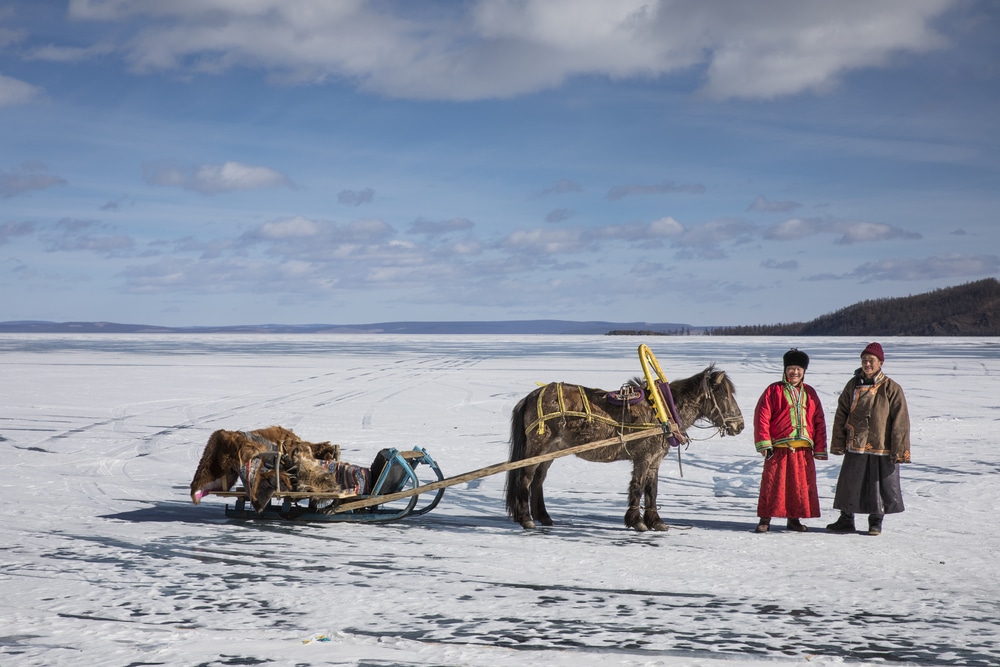
Spring
While most people think of spring as a time when temperatures start to warm up, flowers begin to bloom, and life returns to nature, spring in Mongolia isn’t quite that. In fact, spring is still uncomfortably cold and you should probably just think of spring in Mongolia as winter-lite.
Blizzards can still occur in May, which locals refer to as dzud (or zud, a natural phenomenon that kills off a large portion of herds from starvation since they aren’t able to graze), and it’s still a harsh time in the country as locals start to run out of winter rations and look forward to warmer summer months.
However, as is usually the case in Mongolia, the brave are rewarded with two very cool festivals that make a trip to Mongolia in the spring worth it.
The annual Camel Festival is held each March in the Gobi Desert.
During the festival, there are camel polo matches, camel races, and friendly competitions among the local camel breeders. Mongolia is one of the few places in the world where you find Bactrian (two-hump) camels, and the Gobi Desert one of the only deserts in the world where snow accumulates. Making a trip down to the desert during this time is actually quite a magical experience.
Also in March, the annual Ice Festival is held on Lake Khuvsgul, the world’s second-largest freshwater lake. The lake is completely frozen over and is strong enough to drive cars over and host an entire festival on.
And yes, this region bordering Siberia will be every bit as cold as you’d expect it would be, so don’t come unprepared. A fur-lined winter deel (traditional Mongolian robe) probably wouldn’t be a bad investment. You can have one custom-made in Ulaanbaatar as soon as you land.
Here are some other great things to see and experience when visiting Mongolia in March, April, and May:
- Camel Festival
- Ice Festival
- Ulaanbaatar Eagle Festival
Finding a Cheap Flight to Mongolia
Check the cheapest rates to Ulaanbaatar on CheapOair.com below.
The best direct flights to Mongolia are on the following airlines:
- Mongolian National Airline (MIAT)
- Korean Air
- Turkish Airlines
- Air China
- Jeju Air
- Hunnu Air
If you’re traveling from the U.S., your two best options are via Istanbul on Turkish Airlines or via Seoul on Korean Air. I usually recommend traveling via Istanbul if you’re departing from the east coast and via Seoul if you’re departing from the west coast.
Turkish Airlines is my personal preference and I’ve never had an issue with them. I particularly like Turkish Airlines right now because they have a layover program that includes a free 4-star hotel in Istanbul. Besides helping break up your jetlag, it’s also an excuse to cross another country off your list. Two birds, one stone!
From Europe, flying via Frankfurt on MIAT, Mongolia’s national airline, is another good option. As an airline, MIAT is safe, but they don’t always have the best track record for being on time, having a smooth check-in process, and cancellations do happen with them more often than other airlines. I have flown MIAT, but they usually aren’t my first choice.
Internal domestic flights can be booked through MIAT, Aero Mongolia, or Hunnu Air. Domestic roundtrip flights are not cheap, usually costing at least a few hundred U.S. dollars. It’s also extremely confusing to book these flights on your own, especially without a local Mongolian bank account. If you plan to book a domestic flight in Mongolia, I recommend getting a local tour guide or agency to help you through the process.
Once you land in Ulaanbaatar at Chinggis Khaan International Airport, here are the best ways to get from the airport into the city center.
Taking the Trans-Siberian Railway
Taking the Trans-Siberian Railway from Moscow to Beijing is one of the most iconic train journeys in the world. It’s high on my list of things to do, and I’m hoping to do it sooner rather than later.
Conveniently, the Trans-Siberian Railway stops in Ulaanbaatar, giving travelers an excuse to explore the city and surrounding countryside for a few days. The train station is located in the heart of Ulaanbaatar and most hostels and guesthouses offer free transfers from the train station.
Tips for Taking Taxis, Public Transportation, and Hiring a Driving
When it comes to hailing a taxi, finding the bus schedule, or hiring a private driver, there are a few things to know. Use these travel tips for getting around Mongolia cost-efficiently and with less hassle than if you were to have to figure it out on your own.
Finding a Taxi in Ulaanbaatar
You can hail a taxi in Ulaanbaatar simply putting out your hand to your side, signaling you’re looking for a ride.
These are not official taxis, but they are the most common way to get around the city. It’s how I get around almost every day. It’s safe and reliable, but you do need to explain where you’re going. I usually tell the driver a major landmark that’s close enough to where I’m going or I show them on Google Maps. On occasion, the driver will ask for your destination before allowing you in their car, just in case they aren’t going that way. Both male and female drivers stop and do this, sometimes with kids and other family members in the car. It’s all normal here.
When it comes time to pay your driver, expect to pay 1,500 MNT per kilometer. It’s helpful to have small bills and exact change, most drivers don’t carry cash.
If the thought of getting into a strange Mongolian’s car freaks you out, apps like UBCab are the Mongolian equivalent of Uber, which don’t exist in Mongolia. You’ll need a local Mongolian number to register within the app and begin requesting rides. The app is okay from a user perspective and the driver usually calls when they’re on their way to your pickup location.
You’ll still need cash if using UBCab, the app doesn’t accept credit cards. At the end of the ride you’ll see your total in the app, which also helps you get a gauge on the average taxi price to get around the city.
Scooters and Bikes
Ulaanbaatar is now home to both scooter and bike sharing apps.
Jet scooters are hard to miss scattered around town. To use one, download the Jet app (Apple, Android), scan the scooter’s QR code, and then pay by the minute. You can use the app to find a nearby scooter and while they are a convenient way to beat rush hour traffic, Ulaanbaatar’s sidewalks and drivers don’t make it the safest option. Ride with caution!
Hi Sainuu (Apple, Android) is the bikesharing app that’s taken over the city. It works much the same way as Jet and, again, should be used with caution.
Public Transportation in Ulaanbaatar
Buses within Ulaanbaatar are often crowded, especially around rush hour thanks to a lack of routes and other public transportation options. Ulaanbaatar does not have a subway system.
Cash is not accepted once you step on the bus so you’ll need a refillable U Money Smart Card (3,600 MNT to purchase) to take the bus. The price per ride is 500 MNT. You can purchase and refill a U Money Smart Card at bus kiosks around town or inside CU convenience stores. Note that routes and bus numbers will appear in Cyrillic.
You can find information on bus stops, waiting time, routes, and U Money kiosks on the UB Smart Bus app (Apple, Android).
Additionally, it’s possible to take buses from Ulaanbaatar to different cities throughout the country. Bus tickets and schedules are found at the Dragon Center Bus Station, on the outskirts of Ulaanbaatar. You can now purchase bus tickets to destinations outside of Ulaanbaatar online, but be warned the system doesn’t always work as promised. I recommend going to the bus station a day before you plan to depart Ulaanbaatar to get the most up-to-date schedule and purchase your ticket in-person then.
A bus ride to Moron, for example, will be relatively inexpensive, costing 32,000 MNT for the 14-hour ride.
Renting a Car in Ulaanbaatar
Renting a car in Mongolia these days isn’t as cheap as it used to be. In fact, it’s downright expensive. With only two major rental companies to choose from, Avis and Sixt, there’s a monopoly on the car rental market. When you rent from either company, expect to pay a deposit on the rental around $2,000 USD, not including any of your rental costs, which will also need paid up front. If there’s no damage done to the car, you’ll get the deposit money back after returning the rental at the end of your trip.
One hack to that is renting a car through a company like Follow the Tracks. The company offers self-driving tours of Mongolia and these cars are equipped with rooftop tents and they even give you a route to follow.
Another reason I really like Follow the Tracks is because it can be very difficult to navigate Mongolia on your own. Once you leave the city the roads conditions start to worsen, and fast.
Unless you’re a driver who’s really comfortable driving off-roading, and in extreme conditions, I don’t recommend renting a car in Mongolia.
Instead, hire a driver.
Hiring a Driver in Mongolia
There are a few benefits to hiring a driver in Mongolia.
First, like I mentioned above, unless you are really comfortable driving off-road, driving in Mongolia is not easy.
Second, you can’t beat the cost. The cost per day to hire a driver with a car in Mongolia is currently 200,000 MNT per day. You are responsible for the driver’s meals, making sure they have a place to sleep, and you’ll pay for your own gas along the way. Your gas costs will depend on your route, and the type of car you’re in, but expect to fill up at least three to four times during your trip at 300,000 to 400,000 MNT per tank.
Your driver will need to be paid in cash at the end of your trip. Gas can usually be paid for by credit card at gas stations like Petrovis, but you should also carry emergency cash on you for at least two tanks of gas, just in case.
I recommend hiring a driver with either a Toyota Land Cruiser 200, Toyota Delica, or Russian UAZ furgon. These will be the most reliable cars that will get you across the steppe. UAZ furgons are the least comfortable of the three options, and usually also the cheapest.
Drivers are always flexible, easy going, and ready to fix their own car when something goes wrong. Something I can almost guarantee will happen. Usually drivers don’t speak English, but you’ll quickly learn the key words you need to get through your journey. Never underestimate the power of sign language and Google Translate. Take the time to get to know your driver, they’re funny characters that start to become like family in no time.
Plugs and Voltage
Sockets in Mongolia work with both U.S. (type B plugs with two flat prongs and a grounding pin) and European plugs (type C plugs with two round pins). Each socket has one type of each plug.
So, if you’re coming from the U.S., your device will work in most wall sockets in Mongolia. However, it is important to note that there will be a voltage difference. In Mongolia the sockets are 230 volts, compared to the typical 120 volt sockets we use in the U.S.
Most computer chargers, phone chargers, and other electronics have power converters built into the device to account for these types of voltage differences.
For example, I use my U.S. computer charger without any issue. I plug it right into the socket in my apartment, in coffee shops, in hotels – everywhere – and I’ve never had an issue. The same goes with my phone charger, camera battery charger, drone charger, hair straightener, and just about any other electronic you can think of.
If you’d like to bring a wall charger that will allow you to charge via USB-A and USB-C, I recommend this travel adapter. This two pack also gives you the most charging power out of the shortest available charging time.
When packing for Mongolia, be sure to bring travel adapters, power banks, extra C charging cables, and a solar powered charger, if you have one. Electricity is not reliable or regularly available once you leave Ulaanbaatar, so you need to be prepared if you plan to travel around the country for several days. Especially if you plan to do a homestay or spend time in the more remote corners of the country.
As I mentioned above, be aware that the voltage is much higher in Mongolia than it is in the U.S. (230 V vs 120 V). If you plan to plug directly into the wall socket make sure your device has a built-in power converter, or you have a power adapter that allows for dual voltage.
Getting a SIM Card
The best place to get a physical SIM card in Ulaanbaatar is at the State Department Store on the 5th floor. There you’ll find Unitel, MobiCom, Skytel, and gmobile kiosks next to each other. Since they are all located next to each other, it’s easy to browse and compare each company’s service plans and choose the right one for your trip.
Most locals use Unitel, myself included, which offers some of the best service coverage across the country.
Getting a SIM card is quick and easy, but you will need to bring your passport with you to get one issued. You can use a credit card or cash to purchase your car and plan, which should cost less than 40,000 tugrik all together.
If you have an iPhone 15 that doesn’t have a SIM card holder, you can ask for your SIM to be converted to an eSIM. From experience, I know that Unitel offers eSIM cards.
eSIMS are also available in Mongolia and can be purchased through apps like Airalo. Purchasing an eSIM this way is more expensive ($35 USD compared to $10 USD), but it is more convenient and works just as well as using a physical SIM. If you’re short on time and won’t have time to make it to the State Department Store before leaving the city, this is a great option.
Before you purchase a SIM card of any kind, be sure to ask yourself if you really need or want one. Service in the countryside is hit and miss, so even if you purchase a SIM you may not have any data or service.
Only purchase one if it’s absolutely necessary for you to stay connected. Otherwise, enjoy being disconnected, that’s one of the best things about traveling in Mongolia.
If you do decide to purchase a SIM, the two most reliable service providers in Mongolia are MobiCom and Unitel. Tourist plans start as low as 20,000 tugrik and include international call rates, SMS messaging, and different levels of data. No service provider will be able to offer unlimited data, we just don’t have that in Mongolia yet.
Exchanging Cash in Ulaanbaatar
The local currency in Mongolia is Tugriks, also spelled togrog or used as the abbreviation MNT.
As of December 2023, one USD = about 3,455 Tugrik.
You will always need to have cash on hand in Mongolia. Even in Ulaanbaatar where credit cards are becoming more widely accepted. But, you can’t always rely on them to work. It’s especially known that there are issues with Mastercard credit cards and American Express. If you have a Visa credit card, that is your best option for using around the city.
Cash will always be needed if you hail a taxi off the street, and be sure to carry smaller bills on you at all times. Expecting exact change isn’t always possible. I recommend carrying at least ten 1,000 MNT bills, four 5,000 MNT bills, and two 10,000 MNT bills with you at all times. This is still a country where cash is king.
The easiest way to exchange USD or Euros for Tugriks is at one of the currency exchange offices off of Sambuu Street, near the Holiday Inn, where this Google Maps pin is.
There is also a cash exchange stand in the State Department Store, on the third floor, near the kitchen electronics.
ATM’s are more available than cash exchanges in the city, so you can pull out money that way as well. ATM’s typically have a withdraw limit of 500,000 MNT, 800,000 MNT at very select terminals.
Prepare to have what will seem like a large amount of cash on you and note that Mongolia does not use coins.
While most tour operators, guides and private drivers are happy to accept cash in USD or Euros, taxi drivers and local businesses will only accept MNT.
Take my advice and take care of this before you leave Ulaanbaatar for the countryside. Finding working ATMs and currency exchange counters isn’t so easy in the country’s small towns and remote areas.
Visa-Free Countries and How to Get an E-Visa
Citizens from more than 60 countries, including the U.S., Canada, Australia, New Zealand, Germany, Italy, Spain, and the United Kingdom of Great Britain and Northern Ireland can enter Mongolia without needing a visa.
U.S. citizens do not need a visa to enter Mongolia. If you are a U.S. passport holder, and you plan to stay more than 30 days, you will need to register with the immigration office within 7 days of arriving in the country. Then, you can stay up to 90 days without issue. If you fail to register with immigration, you’ll be fined a few hundred dollars at the airport when leaving the country.
Citizens of Canada, Denmark, Belgium, Germany, Iceland, Israel, Italy, France, Spain, Greece, Norway, Sweden, and Switzerland can stay visa-free for up to 30 days.
Citizens from 98 countries, including India, China, Mexico, Saudi Arabia, South Africa, and Armenia can now apply for an electronic visa before departing for Ulaanbaatar.
See the full list of visa-free countries here.
Registering with the Immigration Office
When I first started coming to Mongolia this process had to be done in person at the Immigration Office, which is nowhere near the center of town. Today the process is automated and takes only minutes to complete.
U.S. citizens who plan to stay in Mongolia for more than 30 days need to register with the Immigration Office within 48 hours of arrival.
This has nothing to do with being allowed to stay for up to 90 days visa free. This is absolutely mandatory. I can’t stress this enough. If you fail to register at the Immigration Office you will be stopped at passport control on your way out of the country and not allowed to board your flight until you pay the fine for violating this law. Even worse, you could be banned from entering the country ever again.
Luckily, you can now register with the Immigration Office online.
To register online with immigration you will need to do the following. You will need the information for the person responsible for your stay in the country, including their ID number, email, local phone number, and address. You should have this information before you begin filling out the form.
- Go to https://immigration.gov.mn/en/
- Click “Registration of a Foreign National”
- Follow the steps on the form
- Click submit and you’re all set. The form may not look like it’s been submitted, but it has.
- You won’t receive a confirmation email so I recommend taking a picture of the screen or a screenshot in case there is an issue or dispute when you go to leave the country.
Language and Religion
Mongolian is the official language spoken in Mongolia. It’s written using the Cyrillic alphabet. Although it’s becoming more common to see it written using Latin letters.
Russian and English are the second and third most spoken languages by Mongolians. However, don’t expect most people in Ulaanbaatar to speak English. Most Mongolians don’t.
It will be more likely to find English-speakers in Ulaanbaatar. Once you leave the capital, don’t expect English to be a common language to use for communicating. (You can always use my Mongolian Language Cheat Sheet for help.)
Buddhism is the main “religion” practiced in Mongolia. About 80% of the population considers themselves Buddhist.
Mongolians also believe in respecting the earth and its inhabitants above all else. This is called Tengerism and it was primary religion in Mongolia centuries ago. Today Tengerism and Shamanism still play an important role in the core beliefs of most Mongolians, but they’ll still call themselves Buddhists.
While most of the country’s monasteries were destroyed during Soviet times, a handful can still be found across the country and are worth taking the time to seek out and visit.
Eating and Drinking in Mongolia
There are many amazing traditional Mongolian dishes to taste during your travels. From homemade buuz (dumplings) to tsuvian (friend noodles with dried meat and vegetables) and khuushuur (think: Mongolian hot pocket meets an empanada), you’ll have plenty of opportunities to taste them all. Especially if you’re planning to spend time with a nomadic family in their home.
There are a few important things to remember about eating and drinking in Mongolia.
First, it’s rude to accept food and not finish it. Food is a scarce and sacred resource on the steppe and it should be treated that way.
Second, always accept a plate, cup of tea, or anything else from your host with your right hand or two hands.
Finally, drinking is very common in Mongolian culture. A bottle of vodka for your nomadic host will always go a long way but be warned that (like many post-Soviet countries), alcoholism can be a problem. Always drink with caution and be aware of your surroundings and never drink and drive. Mongolia has a zero tolerance policy.
Besides vodka, airag, or fermented mare’s milk, is another common alcoholic beverage. It’s most commonly consumed in the countryside, where nomadic families make their own brew. Be cautious when drinking airag, your stomach won’t be used to the bacteria and it’s been known to make people run to the toilet. I’m speaking here from experience!
I recommend keeping your drinking to a minimum when you’re staying with a host family. Especially if you’re female or traveling alone.

Travel Insurance and Emergency Healthcare
Getting medical treatment is cheap compared to other countries. I paid about $3,000 all in for surgery in Ulaanbaatar at a private hospital when I broke my collarbone. If I was in the U.S. that same surgery would have probably been $30,000.
The downside of cheap medical treatments is that they aren’t always the most reliable or consistent. While I had a great experience, I can’t say that other foreigners have had the same.
This is why I always recommend purchasing travel insurance for your trip to Mongolia.
Should something terrible happen to you during your trip, such as a horse riding or car accident, your travel insurance policy should cover medical emergencies and evacuation. Be sure to do your research when looking at policies and choose the best one for you, your travels, and your budget.
Look for a policy that also covers trip cancellation in case you need to unexpectedly cancel your travel plans. Trip cancellation policies cover unforeseen events, like an illness, injury, jury duty, or an airline strike. Reimbursable costs in these instances could include transportation, accommodations, and tour costs, up to 100% depending on your policy.
If you experience a medical emergency while in Ulaanbaatar, the phone number is +976 103.
If you experience a medical emergency while outside of Ulaanbaatar, the best thing to do is get to the city as quickly as possible. If you don’t need to, don’t go to one of the local towns for medical treatment.
Hospitals I can vouch for in Ulaanbaatar are:
- UB Songdo Private Hospital
- Intermed
- SOS Clinic
You can find more information, including each hospital’s location and contact information, on our what to do in case of emergency page.
Author: Breanna Wilson
Hi! Sain uu! I’m Breanna, an American travel writer and adventurer living in Ulaanbaatar, Mongolia for more than 5 years. I’ve written for and been featured in Condé Nast Traveler, CNN, Forbes, and the New York Times, among others. Read more of my Mongolia travel articles here.
Join my Private Travel Group on Facebook
Proudly Based in Ulaanbaatar, Mongolia
© 2024 Meanwhile in Mongolia

